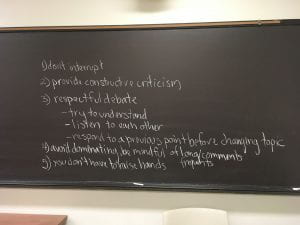 As autumn courses come to an end and we celebrate another successful quarter of online teaching, we also find ourselves already preparing for the winter. With another remote quarter looming, instructors may wonder how to keep students engaged as we approach the one-year milestone of online classes. The Humanities Division is delighted to spotlight its instructors’ approaches to these challenges, and to celebrate their successes and innovations. This week, we sat down with Dominique Bluher, lecturer in Cinema and Media Studies, Romance Languages and Literature, and the Visual Arts, to discuss her experience with student-run virtual discussions.
As autumn courses come to an end and we celebrate another successful quarter of online teaching, we also find ourselves already preparing for the winter. With another remote quarter looming, instructors may wonder how to keep students engaged as we approach the one-year milestone of online classes. The Humanities Division is delighted to spotlight its instructors’ approaches to these challenges, and to celebrate their successes and innovations. This week, we sat down with Dominique Bluher, lecturer in Cinema and Media Studies, Romance Languages and Literature, and the Visual Arts, to discuss her experience with student-run virtual discussions.
Of the classes Dominique Bluher has taught or plans to teach online – Autobiography in Film, Claire Denis, and Contemporary French Cinema – all have a strong emphasis on group discussion as the most important structural aspect of the course. Dominique’s focus has been on making these Zoom meetings engaging and encouraging participation for all students. Her learning goals for the students center on the process of verbally working through the content of difficult films, and gradually deepening the insights that students are able to bring to the table. “It’s like peeling an onion,” she says, and to do so through peer exchange is important. “If I just said everything in a lecture that I make them think through [in discussion], it would have been ‘in one ear, out the other.’” To facilitate these learning goals, Dominique decided that all her discussions would be student-led.
In order to do so, she divided the class into smaller groups with a maximum of ten students per group. For mixed undergraduate/graduate course, she recommends creating a group for the graduate students and one for undergraduate students, since undergraduates can sometimes be reluctant to speak up in a group with graduate students.
For the sake of assigning clear roles in a discussion, students take turns as the discussion leader for each class. Discussion leaders are responsible for producing a handout before the class, and guiding the discussion on Zoom. Before any class meeting, Dominique Bluher meets with the discussion leaders for about an hour. During this time, she guides them in their creation of the handouts, helping them brainstorm, select important quotes from the reading or film, and break down their bullet points by themes and topics. These handouts are posted to Canvas the evening before class, so the other students can read them in advance, and they serve as the backbone for the next day’s discussion.
When it comes time for discussion, the handouts allow students to focus on the important themes, while also moving “freely, fluidly, and organically” from topic to topic. Her students all unmute themselves during discussion, and orient their screens in Gallery View, which she has found helps students speak to the group as a whole rather than to just one person or the teacher. They also make effective use of the Raise Hand feature!
In addition to synchronous Zoom discussions, students post asynchronously using discussion boards on Canvas. In the spring, Dominique Bluher asked students to post before each class period to prepare for the verbal discussion, but found that students were then reluctant to repeat in discussion what they had already posted. This fall, she eliminated written discussion beforehand, and asks students to post on the discussion boards after the class instead. This allows students to comment on insights from the synchronous discussion and add anything they didn’t get the chance to say, as well as give feedback on the format and how to make discussions more productive going forward.
Going into online learning, Dominique Bluher was most concerned about the challenge of truly engaging the students in discussion and facilitating real exchange. She aimed to replicate what happens in an in-person seminar, or at least create something as close as possible to the classroom setting. Looking back on the spring and fall quarters, she can affirm that her student-led discussion format achieved her goal of engaging, productive discussions. She received feedback from students that it was one of the liveliest Zoom discussions that they had had, and noticed that serving as discussion leader helped students build skills in asking short questions, listening to others, and knowing when to redirect or guide the conversation.
“How I conceive of it is, first I’m the composer, when I create the syllabus,” Dominique says. “Then I’m the conductor. And then, everything depends on the musicians. Of course, everything depends on how comfortable the students are with speaking, and how they engage with the material.”
When asked what advice she would give to instructors planning for winter quarter who are looking to encourage student engagement and discussion over Zoom, Dominique Bluher stressed the importance of the one-on-one meetings she had with the discussion leaders. These served to allow the discussion leaders to work through the main questions beforehand, freeing them during the in-class learning process to guide other students to those insights and giving them confidence in what they’re bringing to the group. She also recommends a handout or similar script which can serve as a backbone but still allows for improvisation. Dominique also mentions that it is important in student-run discussions for instructors not to impede. Thus, the students will also learn how to prepare and run a discussion, which is a crucial skill in any working environment.
“The students here are super smart,” she says, “so it’s just to build upon their capability and to encourage these kinds of [discussions], and they’re very hungry for that. That was also one of the reasons I really wanted to not shift to asynchronous learning, because everybody wants to create a community where it’s safe to speak and it’s safe to be insecure about things. I think this was also why [synchronous discussion] was working so well, because we want to focus on something else and we want to have meaningful insight for discussion with others. So I think it was, for me, very important to try to create something for the missing part in our lives, that we cannot be together, so to live these moments of stimulating exchanges.”
Dominique Bluher considers the instructor’s role in these discussions to be a balancing act. Her focus is to structure the class in a way that is the liveliest and most engaging, and the question often arises of how much involvement she can have with discussion leaders beforehand or even during class so as not to “take the air out” of the discussion. Ultimately, she believes that “the important thing is that they’re enjoying their responsibility and developing their skills to engage with their peers.” Find ways to retreat, Dominique counsels. “Be the conductor but let the students make the music.”
Author’s Note: Avid readers may notice that our interviewees utilize and suggest very different online formats. This is intentional! As Claudia Brittenham said in her interview last month, the important thing is that the Division offers variation for students to choose from, and that instructors communicate clearly with their students about the format of their course. When structuring your own courses, go back to your learning goals and think about which format works best for you and your class!


